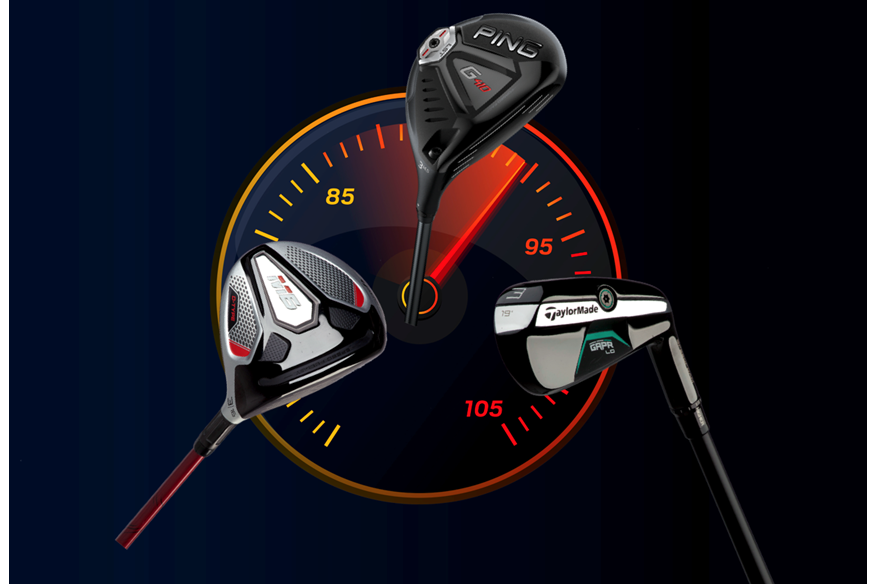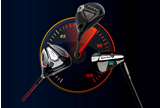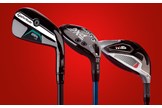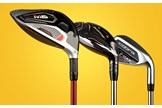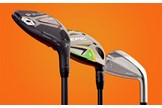Gapping: How to choose the right clubs for the top of your bag
Last updated:
There have never been more options when it comes to choosing the clubs for the top of your bag… here’s how to make sure you get it right
How confident are you about how far each club goes once you get above something like a 6 or 7-iron?
For lots of us, a 5-iron goes “about the same distance” as a 4-iron or hybrid, then there’s a big jump to a 3-wood. That kind of set-up will hurt your game.
We are allowed to carry 14 clubs for a reason – to cover off everything from 50 to 200+ yards with a full swing. If three of those clubs go roughly the same distance – or if they’re so inconsistent you hardly ever use them – you need to fix the gapping at the top of your bag.
We’ve talked to some of the UK’s top clubfitters to work out which type of clubs perform better at certain swing speeds – which carry furthest, launch highest (so stop faster) and which are most forgiving.
ROBOT TESTED: Which golf ball suits my game?
We’ve broken the swing down into three common club golfer swing speeds – 105mph, 95mph and 85mph – based on insight from those club tters. We’ve split each swing speed up depending on whether you prefer to hit – fairway woods, hybrids or long irons – and given some of our favourite options in each category.
Three things you need to know about gapping
1. The absolute best way of getting your gapping spot on is working with an experienced fitter and using a launch monitor like Foresight Sports’ GC Quad. Establish which is the longest iron you hit with any confidence and how far you hit it. Then hit your driver, make a note of how far it goes, then work on filling the gaps between your longest iron and driver with the clubs that not only fill you with confidence, but also cover off consistent yardage gaps between the pair. Be prepared to hit a decent amount of shots – many fitters will look at your long game like this when you buy a set of irons, just to make sure you get the right set-up for your game.
Find your closest Foresight GC Quad launch monitor here
2. It’s not always possible to get on a launch monitor and work with an experienced fitter to dial in your long game gapping, particularly if you’re not looking at buying anything new. So, how about instead spending a session at one of the 50+ Toptracer equipped ranges across the UK, specifically to look at your gapping? You get access to all the same information (ball speed, backspin, peak height, carry distance etc etc) you’ll find on a decent launch monitor, and every ball flight is shown on screen just like on TV nowadays at tour events. To find your nearest Toptracer range, just visit www.toptracer.com/locations
3. Knowing how far you hit every club in your bag, and how much you can take off each with a three- quarter swing, is absolutely essential, particularly as golfers rely on GPS or laser yardages like never before. But you don’t have to spend time getting custom fitted or working on a range to understand your gapping, and how far you hit each club. Shot tracking can work it all out for you, and do it while you play. Arccos and Shot Scope are our favourite shot trackers; once you’ve played a handful of rounds the systems average exactly how far you hit each club. Alternatively you could get your hands on Garmin’s new Approach G80 which isn’t just a GPS handheld, it’s a portable launch monitor, too.
If your swing is around 85mph: Modern fairway woods and wide-body hybrids are designed exactly for you
When we say 85mph, we mean that’s your club speed with a driver, not a fairway wood, hybrid or iron. It’s frequently referred to as a “moderate” swing speed, and more and more brands make ranges tailored to it.
Once they get over 60 many golfers lose about 0.5mph every year from their swing speed, and a 2.5mph loss over five years has a huge influence on how you launch shots into the air. Don’t be afraid to go deep into the set with fairways or hybrids – 2009 US PGA Champ YE Yang had a 3-wood, 2-, 4- and 5-hybrid in his bag for this year’s PGA Championship at Bethpage Black.
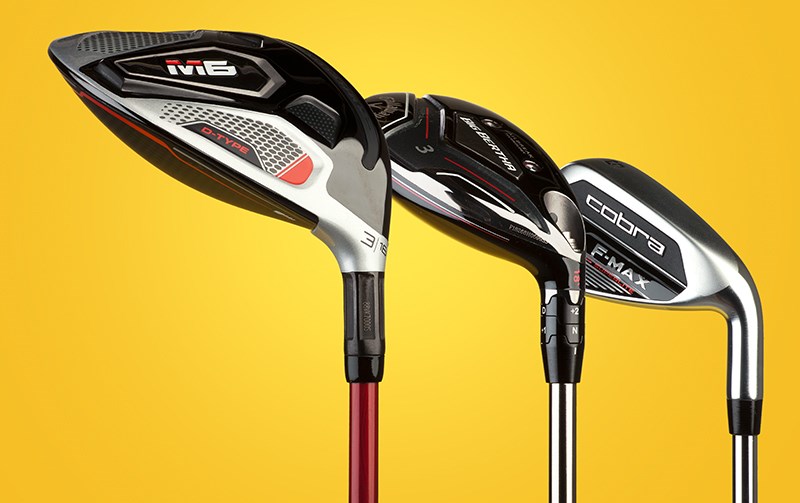
Fairway Woods
At this swing speed there’s little doubt for the majority of golfers that fairway woods and hybrids help launch shots into the air and keep them there for longer.
It’s down to their wider bodies and deeper centre of gravity location. It’s widely accepted by fitters that the lower the swing speed, the more headcovers a golfer should have in their bag.
If you prefer hitting fairways before irons or hybrids, give serious thought to really high lofted fairway woods. Callaway makes a 7W (21°), 9W(23°) and 11W (25° –almost a Big Bertha 6-iron!), as part of their Epic Flash line-up. TaylorMade and Ping both offer a 9-wood in the M6 and G410 ranges, and Cobra makes the lighter F-Max Superlite family which is aimed at this swing speed. It’s also worth giving serious thought to draw-biased models, as golfers with moderate swing speeds often need a little help squaring the club at impact (which helps counteract a slice). Ping’s G410 SFT and the TaylorMade’s M6 D-Type fairways have been designed with slightly bigger, wider heads, extra heel side weighting, along with extra loft and a lighter swing speed specifically for this type of player.
Clubs to consider: Callaway Epic Flash, Ping G410, Ping G410 SFT, Cobra F-Max Superlite, TaylorMade M6, TaylorMade M6 D-Type
Hybrids
Proper custom fitting is all about listening and learning from a golfer’s individual game, and if you prefer hitting hybrids instead of fairways or long irons, there are plenty of options. Think seriously about wide-body heads like Callaway’s Big Bertha, as the deeper centre of gravity makes them very playable at this swing speed. And don’t be afraid to look at replacing down to a 7-iron (or more) with hybrids; that’s exactly why Callaway makes 3H-8H (where the 8H has a 33° loft, almost the same as a Big Bertha 8-iron) in the Big Bertha family. Adjustable hosels mean you can dial in specific lofts to fill your own yardage gaps, too. Ping’s G410 hybrid also has extra draw bias in the higher lofts.
Clubs to consider: Callaway Big Bertha, Ping G410, TaylorMade M6
Irons
It’s generally accepted if you can hit long irons, they’ll be slightly more accurate than a hybrid or fairway thanks to the shorter shaft reducing dispersion. At this speed it’s likely your set will stop at a 6-iron, and it’s very common to need bigger loft gaps between your clubs to see good carry distance gaps. If you insist on using long irons rather than fairways and hybrids, look at lighter ranges, and those that don’t have the strongest lofts, as extra loft helps flight shots better at moderate swing speeds.
Clubs to consider: Cobra F-Max, Callaway Big Bertha, TaylorMade M CGB
If your swing is around 95mph: You could probably play anything, so the decision comes down to your preference
A typical 14-15 handicapper has an average driver swing speed of 93mph, so if your club speed is anywhere between 90-95mph you’re pretty much bang on average. This sort of speed equates to an average drive of 214 yards, which doesn’t sound like a lot, but bear in mind that’s an average, which accounts for mishits as well as your Sunday best. The decision about whether to gap your long game with fairway woods, hybrids or long/utility irons (or a combination of them all) is very open at this swing speed and will likely be governed by technique and personal preference.
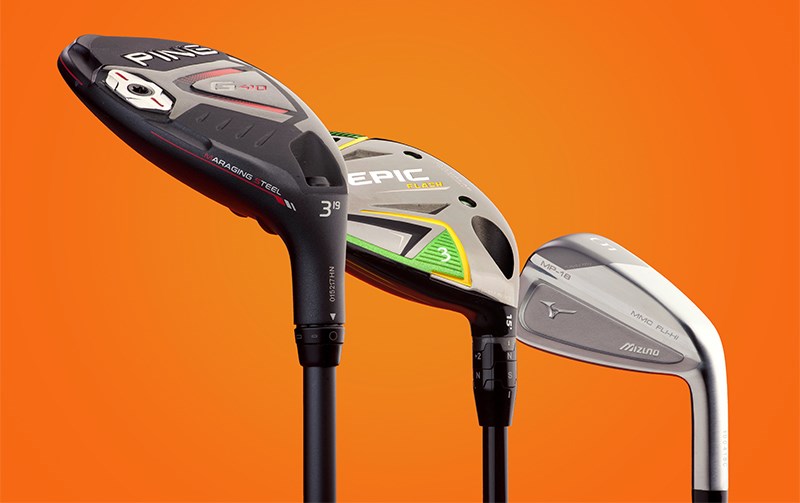
Hybrids
It’s been almost 20 years since TaylorMade introduced the first Rescue, and since then hybrids have helped countless golfers hit higher, straighter, longer and more consistent long game shots. Simply, hybrids are much more forgiving than a traditional long iron, and it’s all down to the wider, hollow head having extra weight lower, and a centre of gravity further from the face. Hybrids can be split roughly into body width categories. Narrower heads (like the Callaway Apex) tend to be better suited to golfers who attack down into their hybrids, engaging the turf like an iron.
Wider bodies (like the Ping G410 and TaylorMade M6) often give “sweepers” – golfers who hit hybrids like fairway woods, and sweep shots off the deck – better results. Narrow bodies tend to spin less and are a bit more workable, whereas the extra spin created by wider models can help hold shots in the air for longer, which can aid carry distance for swing speeds at the lower end of this category.
If you’ve tried hybrids before and found you have a tendency to pull shots left of the target, look for narrow body models, they tend to have less draw bias. Titleist 818s have a movable centre of gravity, so it’s possible to dial in a neutral shot bias. Don’t think you need to replace a 4-iron with a 4 hybrid – you don’t. The two aren’t evenly matched for shaft length or spin. Instead, look at carry distance and make sure you have accurate yardage gaps to your longest iron and shortest fairway wood.
Clubs to consider: Taylormade M6, Callaway Apex, Ping G410, Titleist 818
Irons
Depending on your technique, golfers at this sort of speed are likely to have a 5-iron in the bag, possibly a 4-iron, too. The area to pay special attention to here is making these longer irons as friendly and playable as possible. Think about using utility irons that bring extra forgiveness to the party – Mizuno’s MP-18 MMC Fli-Hi is a great example. It’s more forgiving than the standard MP-18 MMC iron, and they run from 2-6 irons. Fli-Hi flights shots higher, so they land at a steeper angle making the ball more likely to stop on a green. A flexible maraging steel face and internal pocket help improve and retain ball speeds, valuable attributes when flying approach shots over hazards on to a green from distance.
Clubs to consider: Ping G410 Crossover, TaylorMade GAPR MID, Mizuno MP-18 MMC Fli-Hi
Fairway Woods
Don’t think just because you own a reasonable swing speed, a 7-wood (or higher lofted fairway) can’t bring something to the table when it comes to gapping the long game. There are plenty of pros who put a 7-wood in play at different points in the season. Think about which shots you most regularly need to hit. If a 7-wood gives the high ball flight and extra spin needed to hit a couple of par 5s, or hold the green on a long par 3 over water – while also being really forgiving from the tee and turf – why shy away from one? Smaller heads like that on PXG’s 0341 X Gen 2 look great behind the ball. Bigger, wider but low profile heads like Ping’s G410 can help forgiveness from the turf for less confident fairway players.
Clubs to consider: PXG 0341 X GEN 2, TaylorMade M6, Ping G410
If your swing is around 105mph: You’re likely a decent golfer who could well get the best from a modern utility iron
Congratulations you’re one of only 22 per cent of male amateur golfers who have a swing speed over 101mph. TrackMan researched the average male golfer and found a direct link between club speed and handicap.
So if you swing the driver at 105mph it’s likely your handicap will be closer to single figures than the teens. And all that speed and velocity, plus a downward attack angle, makes it possible to launch lowerlofted long irons from the deck.
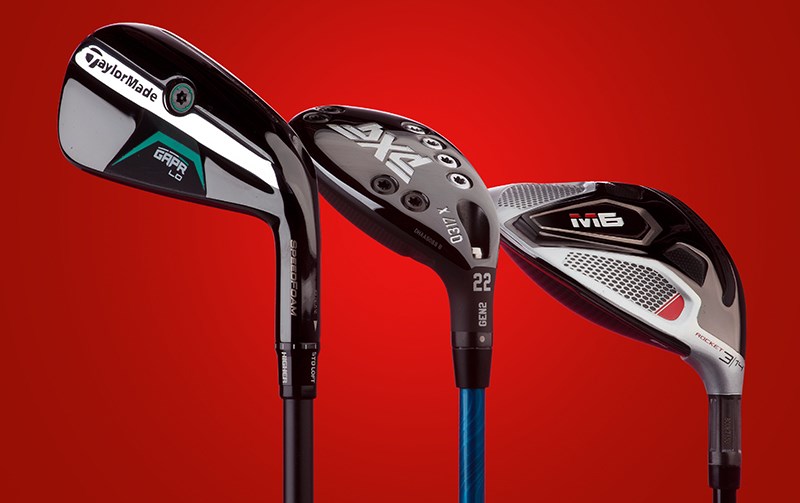
Irons
It’s no surprise at this swing speed golfers are more likely to have a 4-iron in the bag (thanks to their shorter shafts irons are more accurate). It’s not uncommon to have a specialist utility or driving iron as a driver replacement, too, which comes into play when accuracy from the tee takes precedence over distance.
Hollow body utility long irons are a growing trend, as their internal cavity improves forgiveness over traditional blade irons. Models like the TaylorMade GAPR LO, which are specifically tailored to increase ball flight control as they deliver a powerful penetrating ball flight. Think very carefully about the types of courses you play and which shots are demanded from each set up. Pros often flit between driving irons and fairway woods at The Open, basing their decision on the conditions and also how they intend to play the golf course. Long and utility irons can be better for lower flighted shots which run out further, but aren’t great for carrying hazards and stopping shots quickly.
Give serious consideration to looking at irons as individuals, too. It means you can choose your exact mid and long iron set-up, and Ping, Mizuno and Titleist all sell irons separately. Also look at combo sets. TaylorMade’s P760s offer a little extra playability (hollow heads and fast face tech) in the mid and long irons but are also great looking compact, one-piece forged heads in the shorter irons.
Clubs to consider: Ping G410 Crossover, Mizuno MP-18 MMC Fli-Hi, TaylorMade GAPR LO
Hybrids
A recent poll asked which long game club golfers preferred; 64 per cent opted for hybrids over long or utility irons or fairways (18 per cent preferred fairways, 12 per cent preferred traditional long irons with six per cent preferring utility irons), so you’re in good company if your preferred choice is a hybrid.
Your extra club speed is highly likely to be more suited to narrower bodies unless your specific taste is for wider models. Narrow bodies spin less, which is likely to improve control in the right hands. Look for clues in shaft weights as to who each is model aimed at. TaylorMade’s GAPR Lo has a 77g (reg flex) where the M6 hybrid equivalent is just 68g. Lighter, more lively shafts “pop” shots up into the air where heavier models often drive shots forward instead of upwards. PXG’s 0317 X Gen 2 hybrid is a decent low-spin option.
Clubs to consider: TaylorMade GAPR HI, Callaway Apex, PXG 0317 X Gen 2
Fairway Woods
It’s not uncommon for top players like Rory and Tiger to carry two fairway woods in their bags and their usual set up is a stronger 3-wood and higher lofted 5-wood. If you can find a low-lofted fairway which you’re confident launching from both the deck and tee (as a driver replacement) in a single club you’re laughing. It’s likely to bring par 5s into range in two and gives a reliable teeing off club when under pressure.
Seriously consider adjustable hosel models, like Mizuno’s ST190 3TS. The adjustability not only lets you play with specific yardage gaps, but also to set up how the club looks at address. If you go with a two fairway set-up, make sure there’s a definitive yardage difference between them and ensure you have the gap covered between 5-wood and your next shortest club, whether that be an iron or hybrid. And if you hit 3-wood for safety, it really shouldn’t go as far as your driver.
Clubs to consider: Ping G410 LST, Mizuno ST190
